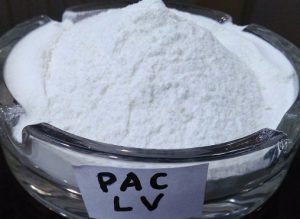
PAC LV acts as an effective agent in sealing the well, controls the viscosity of the drilling fluid and helps prevent erosion and cracking of the well walls.
What is PAC LV Bentonite?
Polyanionic cellulose (PAC) is a natural polymer derived from cellulose, which is one of the most important additives in the oil and gas well drilling industry due to its unique rheological and stabilizing properties.
This polymer material is used to control the viscosity and stabilize the walls of the well in the modulation of drilling fluids. PAC LV acts as an effective agent in sealing the well, controls the viscosity of the drilling fluid and helps prevent erosion and cracking of the well walls.
Application of polyanionic cellulose drilling
PAC LV performs well in managing fluid loss in water-based drilling mud systems such as fresh water, water, KCL and salt. Also, it gives the risk of differential adhesion. PAC LV has good resistance to bacterial adhesion and does not require a preservative.
Polyanionic drilling cellulose is used as an additive to drilling mud and has several functions, which are as follows:
- Stabilize different layers by making appropriate pressure settings
- The formation of an impermeable layer on the wall of the well
- Suspending excavated material or cuttings in the excavation
- Since this material is compatible with chemical environments and is a combination of degradable and non-toxic according to Bikiki, this environment is also very low environmental. This substance is used in and added to aqueous drilling fluids, including petroleum systems. This addition will help stabilize the well and thus increase operating costs.
Introduction to Drilling Fluid Technologies
Drilling fluid technology is constantly evolving due to increasing demands in severe conditions, technical demands, and restrictions on oil-based systems. To comply with government regulations, drilling fluid manufacturers have developed acceptable alternatives, but these often have significant costs and limitations. T
o address these issues, drilling fluid development should focus on designing environmentally acceptable water-based (WBM) and oil-like systems that provide alternatives to oil-based (OBM).
These fluids should provide superior filtration control, prevent fluid invasion, and provide adequate hole cleaning capabilities, especially in horizontal or high-angle wells. The study of cuttings transport flow, air foam behavior, and fluid viscoelastic behavior can help improve this process. To achieve greater efficiencies and cost savings, R&D programs should focus on developing environmentally-benign drilling fluids, designing non-toxic drilling fluids and foams as alternatives to toxic OBM, which are difficult to remove from the drill hole.
The Importance of Drilling Fluids in Wellbore Stability
Wellbore Stability is one of the primary functions of drilling fluid. They help to maintain wellbore stability by providing hydrostatic pressure to counteract the natural pressure of the formations being drilled. The fluid acts as a barrier between the drilling fluid and the surrounding rock formations, preventing caving and other geological issues that could cause damage to the wellbore.
This stability is particularly important when drilling in deep and unstable geological formations. Drilling fluid also acts as a lubricant, reducing the friction and heat generated by the drilling process, which can cause formation damage and reduce the efficiency of the drilling operation.
One of the primary ways in which drilling fluids help maintain wellbore stability is by exerting hydrostatic pressure on the formation being drilled. This pressure helps to prevent the formation from collapsing or caving in, which can lead to well control issues, lost circulation, and other problems. The weight of the drilling fluid is carefully calculated to ensure that it is sufficient to counteract the natural pressure of the formation being drilled.
Another way in which drilling fluids help to maintain wellbore stability is by forming a filter cake on the wellbore walls. This filter cake helps to prevent the drilling fluid from invading the formation and causing damage.
The filter cake is formed by the solids in the drilling fluid, which are deposited on the wellbore walls as the fluid circulates. The thickness and composition of the filter cake can be adjusted to suit the specific needs of the formation being drilled.
What is Bentonite?
Bentonite is a clay generated frequently from the alteration of volcanic ash, consisting predominantly of smectite minerals, usually montmorillonite. Bentonite is essentially a type of swelling clay with an astonishing ability to absorb water, capable of absorbing up to three times its weight in water according to studies.
This water absorption capability makes bentonite an ideal choice for water absorption applications. This makes bentonite beds unsuitable for building and road construction. However, the benefits of bentonite are not limited to its water absorption ability. It also has other useful properties, such as ion exchange and environmental compatibility, which are important and beneficial for various industries.
The Synergy Between PAC LV and Bentonite
When PAC LV and Bentonite are used together, they can achieve several benefits:
Enhanced coagulation and flocculation: PAC LV ability to neutralize charges is complemented by bentonite’s adsorption properties, leading to more effective particle aggregation. Improved
sedimentation: The combined action of PAC LV and Bentonite can result in faster and more complete sedimentation of suspended solids.
Increased turbidity removal: The synergistic effect can enhance the removal of turbidity, making the treated water clearer and more aesthetically pleasing.
Better pollutant removal: Both PAC LV and Bentonite can adsorb various pollutants, and their combined action can improve overall water quality.
Improved soil stabilization: In applications like landfill liners or soil erosion control, the combination of PAC LV and bentonite can provide enhanced stability and strength.
The Role of PAC LV Bentonite in Drilling Fluids
PAC LV is a water-soluble polymer derived from cellulose, characterized by its low viscosity and high molecular weight. In drilling fluid systems, PAC LV functions as a rheology modifier and fluid loss control agent, imparting desirable properties to the drilling fluid.
The behavior and result of these viscosities in an exceeding lubricator typically depend upon the scale of the polymer’s molecules and their charge (e.g., anionic, cationic, or non-ionic).
The PAC LV Polyanionic cellulose is additionally a Fluid loss reducer that could be used in a mud-in step with this invention if desired. Some common fluid loss reducers embrace, for instance, starches or CMC, and a number of these chemicals may have viscosities perform. This excellent loss reducer could give steric stabilization for the non-ionic Surfactants.
Both water and organic solvents will function as the basis for drilling fluids, but today’s environmental protection needs and technological options of well processes verify the employment of water-based drilling fluids in most cases.
Bentonite’s Contribution to Drilling Mud Viscosity
This smectite deposit is typically added to the drilling fluid process as a key component to improve the mud’s viscosity and suspension properties. It helps to create a thixotropic gel-like consistency that aids in the removal of drill cuttings from the wellbore.
PAC LV Applications
PAC LV is effective in managing fluid loss in various mud systems such as Fresh water, Sea water, KCL, and Salt. In addition, it lowers the risk of differential sticking. PAC LV also has a resistance to bacterial attachment which negates the requirement for preservatives.
Compatibility of PAC LV and Different Bentonite Types
The compatibility between polyaluminum chloride (PAC LV) and various bentonite types can significantly influence the overall performance of water treatment or soil stabilization processes. The choice of bentonite should be carefully considered based on factors like its swelling capacity, cation exchange capacity, and particle size distribution.
Factors Affecting Compatibility
PAC LV type: The basicity and aluminum content of PAC LV can influence its interaction with bentonite.
Bentonite properties: The swelling capacity, cation exchange capacity, and particle size distribution of bentonite can affect its compatibility with PAC LV.
Water quality: The characteristics of the water being treated, such as pH, alkalinity, and the presence of specific contaminants, can influence the interaction between PAC LV and bentonite.
Application: The specific application, whether water treatment or soil stabilization, can dictate the optimal combination of PAC LV and bentonite.
Advantages of Using PAC LV
The incorporation of PAC LV offers several advantages in drilling operations. Firstly, it enhances fluid viscosity, improving hole-cleaning efficiency and hydraulic performance.
Additionally, PAC LV aids in fluid loss control by forming a protective barrier against formation fluids, reducing the risk of wellbore instability. Furthermore, PAC LV exhibits temperature stability, retaining its effectiveness across a wide range of drilling conditions.
Rheological Behavior of PAC LV Bentonite Drilling Fluids
The experimental results showed that the ultrasound increased the viscosity and yield point of bentonite suspension by reducing the particle size of clay, destroying the network structure between clay particles, increasing the mud yield and the cation exchange capacity of bentonite, and promoting the hydration dispersion of bentonite. The change of rheological property showed a memory effect at room temperature and high temperature.
Besides, the ultrasonic energy affected the network structure between clays and polymer chains, thus regulating the rheological properties of the bentonite-polymer system. For two types of drilling fluids investigated, the rheology of the poly-sulfonate drilling fluid was regulated by damaging the grid structure between additives and clays by low-power ultrasound and reducing the clay particle size by high-power ultrasound, while the rheology of the deep-water drilling fluid was mainly regulated by disentangling the spatial grid structure between additives.
Additionally, ultrasound showed no effect on the lubricity, inhibition and stability of drilling fluids, which proved the feasibility of ultrasound to regulate rheological properties of water-based drilling fluids.
Summary
PAC LV (Polyanionic Cellulose Low Viscosity) is a key additive in water-based drilling fluids, derived from cellulose.
PAC LV controls fluid viscosity, reduces fluid loss, and stabilizes wellbore walls by forming a filter cake, thereby preventing erosion and damage.
It is particularly effective in various water-based mud systems (e.g., freshwater, seawater, KCL, and salt) and offers bacterial resistance, removing the need for preservatives.
Physical Properties
| Parameter | Specifications |
|---|---|
| Appearance | Off white to Creamish free flowing powder |
| Nature of Polymer | Poly Anionic Cellulose |
| Purity | 99% Min |
| Moisture Content | <10 % |
| PH of 1% Solution | 6.0-7.5 |
| Degree of Substitution | 0.9 Min |
| Sodium Chloride content | 0.02%max |
| Solubility | Soluble in fresh water , Insoluble in oil |
| Toxicity | Non Toxic |
| Filtrate Volume | Max. 10.0 ml |
| Temperature Stability | >150 Deg C |

